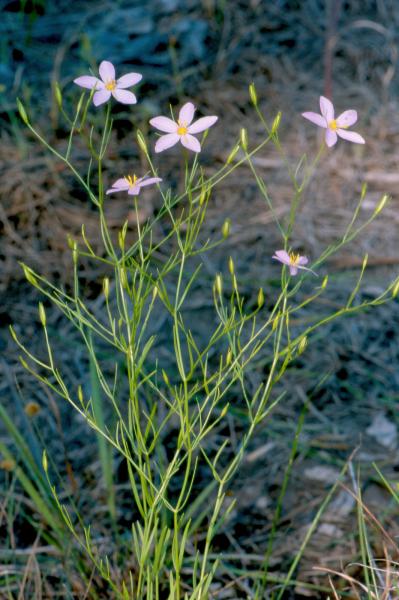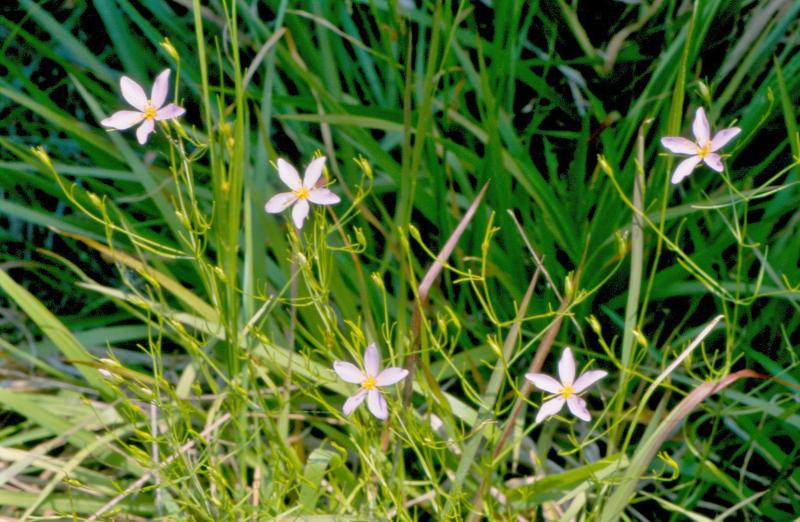Slender Marsh Pink
Sabatia campanulata (L.) Torr.
- Class
- Dicotyledoneae (Dicots)
- Family
- Gentianaceae (Gentian Family)
- State Protection
- Endangered
Listed as Endangered by New York State: in imminent danger of extirpation in New York. For animals, taking, importation, transportation, or possession is prohibited, except under license or permit. For plants, removal or damage without the consent of the landowner is prohibited.
- Federal Protection
- Not Listed
- State Conservation Status Rank
- S1
Critically Imperiled in New York - Especially vulnerable to disappearing from New York due to extreme rarity or other factors; typically 5 or fewer populations or locations in New York, very few individuals, very restricted range, very few remaining acres (or miles of stream), and/or very steep declines.
- Global Conservation Status Rank
- G5
Secure globally - Common in the world; widespread and abundant (but may be rare in some parts of its range).
Summary
Did you know?
Many species of Sabatia occasionally sport white flowers instead of the usual pink ones. These plants were given form names including forma albina for this species (Fernald 1950) but these names are rarely used today.
State Ranking Justification
There are four existing populations but two of them are threatened by the invasion of Phragmites. There are two additional historical populations from the early 1900s, one on Long Island and one on a Hudson River brackish marsh, that are probably extirpated. It is now known only from Suffolk County on Long Island. It has been extirpated from the rest of Long Island and from reported sites on Staten Island and Manhattan Island, and from the inland salt marshes near Syracuse.
Short-term Trends
The short-term trends are stable. The existing populations have been doing well since 1985.
Long-term Trends
The long-term trend is somewhat negative. This plant was always very rare in New York with only five known historical populations. Three of the historical populations have been rediscovered. Future trends may be downward without control of non-native Phragmites.
Conservation and Management
Threats
Phragmites is a problem that two of the sites and it must be managed for the populations to thrive. Another population is near a closed sand road that if reopened, could change the hydrology of the wetland.
Conservation Strategies and Management Practices
Control Phragmites invasions in the salt marshes where it exists and prevent new incursions. Natural buffers should be established around the salt marshes to decrease pollution runoff and other direct human disturbances.
Research Needs
Research is needed to refine techniques to augment populations after Phragmites removal.
Habitat
Habitat
In New York this plant is mostly known from high salt marshes, some of them dominated by graminoids. It can also be found in fresh to brackish meadows, the edge of salt/brackish ponds, sea level fens, and small shallow brackish or freshwater depressions in dunes. (New York Natural Heritage Program 2012). Very rare in marshes and wet fields (Rhodes and Block 2000). Damp sands and peats, pine savannas, and ditches along the coastal plain (Crow and Helquist 2000). Moist or wet places along the coastal plain (Gleason and Cronquist 1991). Damp sands and peats (Fernald 1970).
Associated Ecological Communities
- Brackish interdunal swales
(guide)
Temporarily tidally flooded temperate marshes in interdunal swales dominated by salt-tolerant graminoids. Individual swales occur as small patches positioned between fore-, primary and secondary dunes in a maritime dunes system, typically on barrier islands.
- High salt marsh
(guide)
A coastal marsh community that occurs in sheltered areas of the seacoast, in a zone extending from mean high tide up to the limit of spring tides. It is periodically flooded by spring tides and flood tides. High salt marshes typically consist of a mosaic of patches that are mostly dominated by a single graminoid species.
- Maritime freshwater interdunal swales
(guide)
A mosaic of wetlands that occur in low areas between dunes along the Atlantic coast; the low areas (swales) are formed either by blowouts in the dunes that lower the soil surface to groundwater level, or by the seaward extension of dune fields. Water levels fluctuate seasonally and annually. Sedges and herbs are usually the most abundant types of plants. These wetlands may be quite small (less than 0.25 acre).
- Saltwater tidal creek*
(guide)
The aquatic community of a shallow, tidally flooded saltwater or brackish creek with submerged areas averaging less than 2 m (6 ft) deep at low tide.
- Sea level fen
(guide)
A wetland that occurs at the upper edge of salt marshes but is fed primarily by acidic groundwater seeping out along the upland edge. This fresh water sometimes mixes with salt or brackish water during unusually high tides. There is a high abundance of sedges that decompose slowly and create a deep substrate of peat. This peat is underlain by deep sand or gravel. These fens usually have a high diversity of herbs but may also have scattered trees and shrubs.
* probable association but not confirmed.
Associated Species
- Andropogon virginicus
- Cirsium horridulum
- Euthamia graminifolia (common flat-topped-goldenrod)
- Helianthus angustifolius (swamp sunflower)
- Iris prismatica (slender blue iris, slender blue flag)
- Myrica pensylvanica
- Osmunda regalis
- Panicum virgatum (switch grass)
- Polygala cruciata (cross-leaved milkwort)
- Ptilimnium capillaceum (mock bishopweed)
- Sabatia stellaris (sea-pink)
- Schoenoplectus americanus (chair-maker's bulrush)
- Vaccinium macrocarpon (cranberry)
Range
New York State Distribution
This saltmarsh wildflower is now known only from Suffolk County on Long Island. It is extirpated from the rest of Long Island, Staten Island, and Manhattan Island.
Global Distribution
This wildflower is most common along the Coastal Plain of the Carolinas south to northern Florida and west to East Texas. There are scattered inland populations in the Southeast north to Kentucky, Virginia, and Indiana and scattered coastal populations from Virginia north through Long Island to eastern Massachusetts.
Identification Comments
General Description
This small perennial wildflower has two-several stems arising from a woody base. The branches are all or mostly alternate. The three-nerved leaves are oblong or narrowly oval to linear with an obtuse apex and base that is broadly rounded and sessile. The upper leaves are very narrow. The calyx lobes are very narrow, widest at the base, and three fourths to as long as the pink, pale crimson, or white corolla with a yellow eye. The petal lobes are 10-15 millimeters long. The style is usually divided to just below the middle.
Identifying Characteristics
Distinguishing characteristics: perenial with a woody caudex, stems usually 2-several; branches all or mostly alternate; primary leaves oblong or narrowly oval to linear, obtuse, broadly sessile; calyx-lobes linear-setaceous, three-fourths to as long as the corolla; corolla pink, pale crimson, or white. Best life stage for ID: in flower. Characters needed to ID: flowering stems with a description of the habitat.
Best Life Stage for Proper Identification
The best time to identify this plant is in bloom when the flower characters can be seen.
Similar Species
Sabatia stellaris is an annual from a single stem and opposite branching. In contrast, Sabatia campanulata is a perennial, typically multi-stemmed, with primarily attenuate branching. The corolla lobes are no more than three-fourths the length of the corolla. The calyx lobes are distinctly shorter than the corolla.
Best Time to See
Flowers August to early September. Fruits are visible to mid-October.
- Flowering
- Fruiting
The time of year you would expect to find Slender Marsh Pink flowering and fruiting in New York.
Slender Marsh Pink Images
Taxonomy
Slender Marsh Pink
Sabatia campanulata (L.) Torr.
- Kingdom Plantae
- Phylum Anthophyta
- Class Dicotyledoneae
(Dicots)
- Order Gentianales
- Family Gentianaceae (Gentian Family)
- Order Gentianales
- Class Dicotyledoneae
(Dicots)
- Phylum Anthophyta
Additional Resources
Best Identification Reference
Gleason, Henry A. and A. Cronquist. 1991. Manual of Vascular Plants of Northeastern United States and Adjacent Canada. The New York Botanical Garden, Bronx, New York. 910 pp.
Other References
Clemants, Steven and Carol Gracie. 2006. Wildflowers in the Field and Forest. A Field Guide to the Northeastern United States. Oxford University Press, New York, NY. 445 pp.
Crow, Garrett E. and C. Barre Hellquist. 2000. Aquatic and Wetland Plants of Northeastern North America: A revised and enlarged edition of Norman C. Fassett's a Manual of Aquatic Plants. Volume One: Pteridophytes, Gymnosperms, and Angiosperms: Dicotyledons. The University of Wisconsin Press. Madison, Wisconsin. 536 Pages.
Fernald, M. L. 1950. Gray's manual of botany. 8th edition. Corrected printing (1970). D. Van Nostrand Company, New York. 1632 pp.
Holmgren, Noel. 1998. The Illustrated Companion to Gleason and Cronquist's Manual. Illustrations of the Vascular Plants of Northeastern United States and Adjacent Canada. The New York Botanical Garden, Bronx, New York.
New York Natural Heritage Program. 2010. Biotics database. New York Natural Heritage Program. New York State Department of Environmental Conservation. Albany, NY.
New York Natural Heritage Program. 2024. New York Natural Heritage Program Databases. Albany, NY.
Newcomb, Lawrence. 1977. Newcomb's Wildflower Guide: An Ingenious New Key System for Quick, Positive Field Identification of the Wildflowers, Flowering Shrubs, and Vines of Northeastern and North-Central North America. Little, Brown and Company. Boston.
Rhoads, Ann F. and Timothy A. Block. 2000. The Plants of Pennsylvania, an Illustrated Manual. University of Pennsylvania Press, Philadelphia, PA.
Weldy, T. and D. Werier. 2010. New York flora atlas. [S.M. Landry, K.N. Campbell, and L.D. Mabe (original application development), Florida Center for Community Design and Research http://www.fccdr.usf.edu/. University of South Florida http://www.usf.edu/]. New York Flora Association http://newyork.plantatlas.usf.edu/, Albany, New York
Links
About This Guide
This guide was authored by: Stephen M. Young, Richard M. Ring.
Information for this guide was last updated on: March 7, 2013
Please cite this page as:
New York Natural Heritage Program. 2024.
Online Conservation Guide for
Sabatia campanulata.
Available from: https://guides.nynhp.org/slender-marsh-pink/.
Accessed July 26, 2024.

